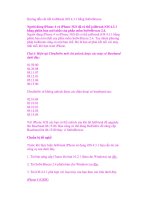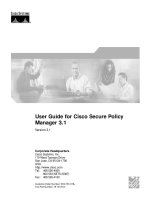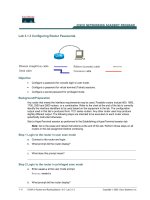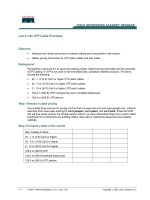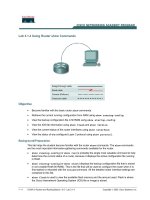Spring Security 3.1 pot
Bạn đang xem bản rút gọn của tài liệu. Xem và tải ngay bản đầy đủ của tài liệu tại đây (6.22 MB, 456 trang )
www.it-ebooks.info
Spring Security 3.1
Secure your web applications from hackers with this
step-by-step guide
Robert Winch
Peter Mularien
BIRMINGHAM - MUMBAI
www.it-ebooks.info
Spring Security 3.1
Copyright © 2012 Packt Publishing
All rights reserved. No part of this book may be reproduced, stored in a retrieval
system, or transmitted in any form or by any means, without the prior written
permission of the publisher, except in the case of brief quotations embedded in
critical articles or reviews.
Every effort has been made in the preparation of this book to ensure the accuracy
of the information presented. However, the information contained in this book is
sold without warranty, either express or implied. Neither the author, nor Packt
Publishing, and its dealers and distributors will be held liable for any damages
caused or alleged to be caused directly or indirectly by this book.
Packt Publishing has endeavored to provide trademark information about all of the
companies and products mentioned in this book by the appropriate use of capitals.
However, Packt Publishing cannot guarantee the accuracy of this information.
First published: May 2010
Second published: December 2012
Production Reference: 1191212
Published by Packt Publishing Ltd.
Livery Place
35 Livery Street
Birmingham B3 2PB, UK.
ISBN 978-1-84951-826-0
www.packtpub.com
Cover Image by Asher Wishkerman ()
www.it-ebooks.info
Credits
Authors
Robert Winch
Peter Mularien
Reviewers
Marten Deinum
Brian Relph
Bryan Kelly
Acquisition Editor
Usha Iyer
Lead Technical Editor
Susmita Panda
Technical Editors
Lubna Shaikh
Worrell Lewis
Copy Editors
Brandt D'mello
Insiya Morbiwala
Alda Paiva
Laxmi Subramanian
Project Coordinator
Michelle Quadros
Proofreader
Mario Cecere
Indexers
Monica Ajmera
Rekha Nair
Graphics
Aditi Gajjar
Production Coordinator
Arvindkumar Gupta
Cover Work
Arvindkumar Gupta
www.it-ebooks.info
About the Author
Robert Winch is currently a Senior Software Engineer at VMware and is the
project lead of the Spring Security framework. In the past, he has worked as a
Software Architect at Cerner, the largest provider of electronic medical systems in
the U.S., securing health care applications. Throughout his career, he has developed
hands on experience integrating Spring Security with an array of security standards
(that is, LDAP, SAML, CAS, OAuth, and so on). Before he was employed at Cerner,
he worked as an independent web contractor, in proteomics research at Loyola
University Chicago, and on the Globus Toolkit at Argonne National Laboratory.
www.it-ebooks.info
Acknowledgement
Before we get started, I would like to extend my thanks to those who helped
me make this book possible. First, I would like to thank Peter Mularien, for
recommending me to Packt Publishing to write the second edition of his book
Spring Security 3, Packt Publishing. It was very useful to have such a sound
foundation to start Spring Security 3.1.
Writing a book is a very involved process and there were many that played a key
part in the book's success. I would like to thank all the members of the team at
Packt Publishing for making this possible. To Usha Iyer, for guiding me through the
process; to Theresa Chettiar, for ensuring that I stayed focused and on time; and to
Susmita Panda, for her diligence in reviewing the book. Thank you to my technical
reviewers Peter Mularien, Marten Deinum, Brian Relph, and Bryan Kelly. Your
feedback was critical in ensuring this book's success.
This book, the Spring Security Framework, and the Spring Framework are all made
possible by the large and active community. Thank you to all of those who contribute
to the Spring Framework through patches, JIRA submissions, and answering other
user's questions. Thanks to Ben Alex for creating Spring Security. I'd like to extend my
special thanks to Luke Taylor for his leadership of Spring Security. It was through his
mentoring that I have grown into a leader in the Spring Security community.
Thank you to my friends and family for your continued support. Last, but certainly
not least, I would like to thank my wife, Amanda. Without your love, patience, and
encouragement, I would have never been able to nish this book. Thank you for
taking such good care of me and reminding me to eat.
www.it-ebooks.info
Peter Mularien is an experienced software architect and engineer, and the
author of the book Spring Security 3, Packt Publishing. Peter currently works for a
large nancial services company and has over 12 years consulting and product
experience in Java, Spring, Oracle, and many other enterprise technologies.
He is also the reviewer of this book.
www.it-ebooks.info
About the Reviewers
Marten Deinum is a Java/software consultant working for Conspect. He
has developed and architected software, primarily in Java, for small and large
companies. He is an enthusiastic open source user and longtime fan, user, and
advocate of the Spring Framework. He has held a number of positions including
Software Engineer, Development Lead, Coach, and also as a Java and Spring Trainer.
When not working or answering questions on the Spring Framework forums, he can
be found in the water training for the triathlon or under the water diving or guiding
other people around.
Brian Relph is currently a Software Engineer at Google, with a focus on web
application development. In the past, he has worked as a Software Architect at
Cerner, the largest provider of electronic medical systems in the U.S. Throughout
his career, he has developed hands on experience in integrating Spring and Spring
Security with an array of Java standards (that is, LDAP, CAS, OAuth, and so on), and
other open source frameworks (Hibernate, Struts, and so on). He has also worked as
an independent Web Contractor.
www.it-ebooks.info
Bryan Kelly is currently a Software Architect at Cerner Corporation,
the largest provider of electronic medical systems in the U.S. At Cerner, his
primary responsibility is designing and implementing solutions that use the
Spring Framework, Spring Security, and Hibernate for Web Applications and
RESTful Web Services. Previously, he has worked as a Software Developer for
CJK Software Consultants. Throughout his career, he has developed hands on
experience in integrating Spring Security with an array of security standards
(that is, LDAP, SAML v1 and v2, CAS, OAuth, OpenID, and so on).
I would like to personally thank Rob Winch for the opportunity to
be a technical reviewer of this book. I would like to thank my wife
Melinda Kelly for her unwavering support while I used my personal
time to review this book. I would also like to thank John Krzysztow
of CJK Software Consultants for giving a high schooler a chance at
professional software development.
www.it-ebooks.info
www.PacktPub.com
Support les, eBooks, discount offers and more
You might want to visit www.PacktPub.com for support les and downloads related
to your book.
Did you know that Packt offers eBook versions of every book published, with PDF
and ePub les available? You can upgrade to the eBook version at
www.PacktPub.
com
and as a print book customer, you are entitled to a discount on the eBook copy.
Get in touch with us at for more details.
At
www.PacktPub.com, you can also read a collection of free technical articles, sign
up for a range of free newsletters and receive exclusive discounts and offers on Packt
books and eBooks.
Do you need instant solutions to your IT questions? PacktLib is Packt's online
digital book library. Here, you can access, read and search across Packt's entire
library of books.
Why Subscribe?
• Fully searchable across every book published by Packt
• Copy and paste, print and bookmark content
• On demand and accessible via web browser
Free Access for Packt account holders
If you have an account with Packt at www.PacktPub.com, you can use this to access
PacktLib today and view nine entirely free books. Simply use your login credentials
for immediate access.
www.it-ebooks.info
www.it-ebooks.info
To my wife for your love, patience, and support throughout this endeavor.
www.it-ebooks.info
www.it-ebooks.info
Table of Contents
Preface 1
Chapter 1: Anatomy of an Unsafe Application 7
Security audit 8
About the sample application 8
The JBCP calendar application architecture 10
Application technology 11
Reviewing the audit results 12
Authentication 14
Authorization 16
Database credential security 18
Sensitive information 19
Transport-level protection 19
Using Spring Security 3.1 to address security concerns 19
Why Spring Security 20
Summary 20
Chapter 2: Getting Started with Spring Security 21
Hello Spring Security 22
Importing the sample application 22
Updating your dependencies 22
Using Spring 3.1 and Spring Security 3.1 23
Implementing a Spring Security XML conguration le 24
Updating your web.xml le 27
ContextLoaderListener 27
ContextLoaderListener versus DispatcherServlet 28
springSecurityFilterChain 29
DelegatingFilterProxy 30
FilterChainProxy 30
Running a secured application 31
Common problems 31
www.it-ebooks.info
Table of Contents
[ ii ]
A little bit of polish 32
Customizing login 33
Conguring logout 36
The page isn't redirecting properly 38
Basic role-based authorization 39
Expression-based authorization 43
Conditionally displaying authentication information 44
Customizing the behavior after login 46
Summary 48
Chapter 3: Custom Authentication 49
JBCP Calendar architecture 49
CalendarUser 50
Event 50
CalendarService 50
UserContext 51
SpringSecurityUserContext 52
Logging in new users using SecurityContextHolder 54
Managing users in Spring Security 55
Logging in a new user to an application 56
Updating SignupController 57
Creating a custom UserDetailsService object 58
CalendarUserDetailsService 58
Conguring UserDetailsService 60
Removing references to UserDetailsManager 60
CalendarUserDetails 61
SpringSecurityUserContext simplications 62
Displaying custom user attributes 63
Creating a custom AuthenticationProvider object 63
CalendarUserAuthenticationProvider 64
Conguring CalendarUserAuthenticationProvider 66
Authenticating with different parameters 66
DomainUsernamePasswordAuthenticationToken 67
Updating CalendarUserAuthenticationProvider 67
Adding domain to the login page 68
DomainUsernamePasswordAuthenticationFilter 69
Updating our conguration 70
Which authentication method to use 73
Summary 74
Chapter 4: JDBC-based Authentication 75
Using Spring Security's default JDBC authentication 75
Required dependencies 76
Using the H2 database 77
www.it-ebooks.info
Table of Contents
[ iii ]
Provided JDBC scripts 77
Conguring the H2-embedded database 77
Conguring JDBC UserDetailsManager 79
Spring Security's default user schema 79
Dening users 80
Dening user authorities 80
UserDetailsManager 81
What other features does UserDetailsManager provide out of the box 81
Group-based access control 82
Conguring group-based access control 83
Conguring JdbcUserDetailsManager to use groups 83
Utilize the GBAC JDBC scripts 84
Group-based schema 85
Group authority mappings 85
Support for a custom schema 86
Determining the correct JDBC SQL queries 87
Updating the SQL scripts that are loaded 87
CalendarUser authority SQL 88
Insert custom authorities 88
Conguring the JdbcUserDetailsManager to use custom SQL queries 89
Conguring secure passwords 91
PasswordEncoder 92
Conguring password encoding 94
Conguring the PasswordEncoder 94
Making Spring Security aware of the PasswordEncoder 94
Hashing the stored passwords 95
Hashing a new user's passwords 96
Not quite secure 97
Would you like some salt with that password 97
Using salt in Spring Security 98
Summary 102
Chapter 5: LDAP Directory Services 103
Understanding LDAP 104
LDAP 104
Common LDAP attribute names 105
Updating our dependencies 107
Conguring embedded LDAP integration 108
Conguring an LDAP server reference 109
Enabling the LDAP AuthenticationProviderNext interface 110
Troubleshooting embedded LDAP 110
Understanding how Spring LDAP authentication works 111
www.it-ebooks.info
Table of Contents
[ iv ]
Authenticating user credentials 112
Demonstrating authentication with Apache Directory Studio 113
Binding anonymously to LDAP 113
Searching for the user 114
Binding as a user to LDAP 115
Determining user role membership 116
Determining roles with Apache Directory Studio 117
Mapping additional attributes of UserDetails 119
Advanced LDAP conguration 120
Sample JBCP LDAP users 120
Password comparison versus bind authentication 120
Conguring basic password comparison 121
LDAP password encoding and storage 122
The drawbacks of a password comparison authenticator 123
Conguring UserDetailsContextMapper 124
Implicit conguration of UserDetailsContextMapper 124
Viewing additional user details 125
Using an alternate password attribute 127
Using LDAP as UserDetailsService 128
Conguring LdapUserDetailsService 129
Updating AccountController to use LdapUserDetailsService 130
Integrating with an external LDAP server 131
Explicit LDAP bean conguration 132
Conguring an external LDAP server reference 132
Conguring LdapAuthenticationProvider 133
Delegating role discovery to UserDetailsService 135
Integrating with Microsoft Active Directory via LDAP 137
Built-In Active Directory support in Spring Security 3.1 140
Summary 141
Chapter 6: Remember-me Services 143
What is remember-me 143
Dependencies 144
The token-based remember-me feature 145
Conguring the token-based remember-me feature 145
How the token-based remember-me feature works 146
MD5 147
Remember-me signature 148
Token-based remember-me conguration directives 149
Is remember-me secure 150
Authorization rules for remember-me 151
www.it-ebooks.info
Table of Contents
[ v ]
Persistent remember-me 152
Using the persistent-based remember-me feature 153
Adding SQL to create the remember-me schema 153
Initializing the data source with the remember-me schema 153
Conguring the persistent-based remember-me feature 154
How does the persistent-based remember-me feature work 154
Are database-backed persistent tokens more secure 155
Cleaning up the expired remember-me sessions 156
Remember-me architecture 158
Remember-me and the user lifecycle 159
Restricting the remember-me feature to an IP address 160
Custom cookie and HTTP parameter names 163
Summary 164
Chapter 7: Client Certicate Authentication 165
How client certicate authentication works 166
Setting up client certicate authentication infrastructure 168
Understanding the purpose of a public key infrastructure 168
Creating a client certicate key pair 169
Conguring the Tomcat trust store 170
Importing the certicate key pair into a browser 172
Using Firefox 172
Using Chrome 173
Using Internet Explorer 173
Wrapping up testing 174
Troubleshooting client certicate authentication 175
Conguring client certicate authentication in Spring Security 176
Conguring client certicate authentication
using the security namespace 177
How Spring Security uses certicate information 178
How Spring Security certicate authentication works 178
Handling unauthenticated requests with AuthenticationEntryPoint 181
Supporting dual-mode authentication 182
Conguring client certicate authentication using Spring Beans 184
Additional capabilities of bean-based conguration 185
Considerations when implementing Client Certicate authentication 187
Summary 188
Chapter 8: Opening up to OpenID 189
The promising world of OpenID 189
Signing up for an OpenID 191
Enabling OpenID authentication with Spring Security 191
Additional required dependencies 192
Conguring OpenID support in Spring Security 193
www.it-ebooks.info
Table of Contents
[ vi ]
Adding OpenID users 195
CalendarUserDetailsService lookup by OpenID 195
The OpenID user registration problem 196
How are OpenID identiers resolved 197
Implementing user registration with OpenID 200
Registering OpenIDAuthenticationUserDetailsService 200
Attribute Exchange 203
Enabling AX in Spring Security OpenID 204
Conguring different attributes for each OpenID Provider 207
Usability enhancements 208
Automatic redirection to the OpenID Provider 210
Conditional automatic redirection 211
Is OpenID Secure 212
Summary 213
Chapter 9: Single Sign-on with Central Authentication Service 215
Introducing Central Authentication Service 216
High-level CAS authentication ow 216
Spring Security and CAS 218
Required dependencies 219
CAS installation and conguration 220
Conguring basic CAS integration 220
Creating the CAS ServiceProperties object 222
Adding the CasAuthenticationEntryPoint 223
Enabling CAS ticket verication 224
Proving authenticity with the CasAuthenticationProvider 226
Single logout 230
Conguring single logout 231
Clustered environments 233
Proxy ticket authentication for stateless services 234
Conguring proxy ticket authentication 235
Using proxy tickets 237
Authenticating proxy tickets 238
Customizing the CAS Server 240
CAS Maven WAR Overlay 240
How CAS internal authentication works 241
Conguring CAS to connect to our embedded LDAP server 242
Getting UserDetails from a CAS assertion 245
Returning LDAP attributes in the CAS Response 246
Mapping LDAP attributes to CAS attributes 246
Authorizing CAS Services to access custom attributes 247
www.it-ebooks.info
Table of Contents
[ vii ]
Getting UserDetails from a CAS assertion 248
GrantedAuthorityFromAssertionAttributesUser Details Service 248
Alternative ticket authentication using SAML 1.1 249
How is attribute retrieval useful 250
Additional CAS capabilities 250
Summary 251
Chapter 10: Fine-grained Access Control 253
Maven dependencies 254
Spring Expression Language (SpEL) integration 254
WebSecurityExpressionRoot 256
Using the request attribute 256
Using hasIpAddress 257
MethodSecurityExpressionRoot 258
Page-level authorization 258
Conditional rendering with Spring Security tag library 259
Conditional rendering based on URL access rules 259
Conditional rendering using SpEL 261
Using controller logic to conditionally render content 261
WebInvocationPrivilegeEvaluator 263
What is the best way to congure in-page authorization 264
Method-level security 265
Why we secure in layers 266
Securing the business tier 266
Adding @PreAuthorize method annotation 267
Instructing Spring Security to use method annotations 268
Validating method security 268
Interface-based proxies 269
JSR-250 compliant standardized rules 270
Method security using Spring's @Secured annotation 271
Method security rules using aspect-oriented programming 271
Method security rules using bean decorators 273
Method security rules incorporating method parameters 275
Method security rules incorporating returned values 277
Securing method data through role-based ltering 277
Pre-ltering collections with @PreFilter 279
Comparing method authorization types 279
Practical considerations for annotation-based security 280
Method security on Spring MVC controllers 280
Class-based proxies 282
Class-based proxy limitations 282
Summary 284
Chapter 11: Access Control Lists 285
Using access control lists for business object security 285
Access control lists in Spring Security 287
www.it-ebooks.info
Table of Contents
[ viii ]
Basic conguration of Spring Security ACL support 289
Maven dependencies 289
Dening a simple target scenario 289
Adding ACL tables to the H2 database 290
Conguring SecurityExpressionHandler 293
AclPermissionCacheOptimizer 294
PermissionEvaluator 295
JdbcMutableAclService 295
BasicLookupStrategy 296
EhCacheBasedAclCache 297
ConsoleAuditLogger 298
AclAuthorizationStrategyImpl 298
Creating a simple ACL entry 299
Advanced ACL topics 302
How permissions work 302
Custom ACL permission declaration 305
Enabling your JSPs with the Spring Security JSP tag library
through ACL 307
Mutable ACLs and authorization 310
Adding ACLs to newly created Events 311
Considerations for a typical ACL deployment 312
About ACL scalability and performance modelling 313
Do not discount custom development costs 315
Should I use Spring Security ACL 316
Summary 317
Chapter 12: Custom Authorization 319
How requests are authorized 319
Conguration of access decision aggregation 323
Conguring to use a UnanimousBased access decision manager 323
Expression-based request authorization 325
Customizing request authorization 326
Dynamically dening access control to URLs 326
JdbcRequestCongMappingService 326
FilterInvocationServiceSecurityMetadataSource 328
BeanPostProcessor to extend namespace conguration 330
Removing our <intercept-url> elements 331
Creating a custom expression 331
CustomWebSecurityExpressionRoot 331
CustomWebSecurityExpressionHandler 333
Conguring and using CustomWebSecurityExpressionHandler 334
How does method security work 334
www.it-ebooks.info
Table of Contents
[ ix ]
Creating a custom PermissionEvaluator 338
CalendarPermissionEvaluator 338
Conguring CalendarPermissionEvaluator 340
Securing our CalendarService 340
Benets of a custom PermissionEvaluator 341
Summary 342
Chapter 13: Session Management 343
Conguring session xation protection 343
Understanding session xation attacks 344
Preventing session xation attacks with Spring Security 345
Simulating a session xation attack 346
Comparing session-xation-protection options 349
Restricting the number of concurrent sessions per user 349
Conguring concurrent session control 350
Understanding concurrent session control 351
Testing concurrent session control 352
Conguring expired session redirect 352
Common problems with concurrency control 353
Preventing authentication instead of forcing logout 354
Other benets of concurrent session control 355
Displaying active sessions for a user 357
How Spring Security uses the HttpSession 359
HttpSessionSecurityContextRepository 360
Conguring how Spring Security uses HttpSession 360
Debugging with Spring Security's DebugFilter 361
Summary 363
Chapter 14: Integrating with Other Frameworks 365
Integrating with Java Server Faces (JSF) 366
Customizations to support AJAX 366
DelegatingAuthenticationEntryPoint 366
AjaxRequestMatcher 367
Http401EntryPoint 368
Conguration updates 368
JavaScript updates 370
Proxy-based authorization with JSF 371
Custom login page in JSF 371
Spring Security Facelets tag library 374
Google Web Toolkit (GWT) integration 377
Spring Roo and GWT 377
Spring Security setup 378
GwtAuthenticationEntryPoint 378
www.it-ebooks.info
Table of Contents
[ x ]
GWT client updates 379
AuthRequestTransport 379
AuthRequiredEvent 380
LoginOnAuthRequired 381
Conguring GWT 382
Spring Security conguration 383
Method security 384
Method security with Spring Roo 386
Authorization with AspectJ 386
Summary 388
Chapter 15: Migration to Spring Security 3.1 389
Migrating from Spring Security 2 390
Enhancements in Spring Security 3 390
Changes to conguration in Spring Security 3 391
Rearranged AuthenticationManager conguration 391
New conguration syntax for session management options 393
Changes to custom lter conguration 393
Changes to CustomAfterInvocationProvider 395
Minor conguration changes 395
Changes to packages and classes 396
Updates in Spring Security 3.1 398
Summary 399
Appendix: Additional Reference Material 401
Getting started with the JBCP Calendar sample code 401
Creating a new workspace 402
Sample code structure 402
Importing the samples 403
Running the samples in Spring Tool Suite 405
Creating a Tomcat v7.0 server 405
Starting the samples within Spring Tool Suite 407
Shutting down the samples within Spring Tool Suite 408
Removing previous versions of the samples 408
Using HTTPS within Spring Tool Suite 409
Default URLs processed by Spring Security 411
Logical lter names migration reference 412
HTTPS setup in Tomcat 413
Generating a server certicate 413
Conguring Tomcat Connector to use SSL 415
Basic Tomcat SSL termination guide 416
Supplimentary materials 417
Index 419
www.it-ebooks.info
Preface
Welcome to the world of Spring Security 3.1! We're certainly pleased that you have
acquired the only published book, fully devoted to Spring Security 3.1. Before we
get started with the book, we would like to give an overview of how the book is
organized and how you can get the most out of it.
Once you have completed reading this book, you should be familiar with key
security concepts and understand how to solve the majority of the real-world
problems that you will need to solve with Spring Security. Through this discovery,
you will gain an in-depth understanding of the Spring Security architecture, which
will allow you to handle any unexpected use cases the book does not cover.
The book is divided into four main sections. The rst section (Chapters 1 and 2)
provides an introduction to Spring Security and allows you to get started with
Spring Security quickly. The second section (Chapters 3 to 9) provides in-depth
instructions for integrating with a number of different authentication technologies.
The next section (Chapters 10 to 12) explains how Spring Security's authorization
support works. Finally, the last section (Chapters 13 to 15) provides specialized
topics and guides that help you perform very specic tasks.
Security is a very interwoven concept and as such so are many of the topics in the
book. However, once you have read through Chapters 1 to 3, each chapter in the
book is fairly independent of another. This means that you can easily skip from
chapter to chapter and still understand what is happening. The goal was to provide a
cookbook style guide that when read in its entirety still gave a clear understanding of
Spring Security.
www.it-ebooks.info
Preface
[ 2 ]
The book uses a simple Spring Web MVC-based application to illustrate how to
solve real-world problems. The application is intended to be very simple and
straightforward, and purposely contains very little functionality—the goal of this
application is to encourage you to focus on the Spring Security concepts, and not
get tied up in the complexities of application development. You will have a much
easier time following the book if you take the time to review the sample application
source code, and try to follow along with the exercises. Some tips on getting started
are found in the Getting started with the JBCP Calendar sample code section in Appendix,
Additional Reference Material.
What this book covers
Chapter 1, Anatomy of an Unsafe Application, covers a hypothetical security audit of
our Calendar application, illustrating common issues that can be resolved through
proper application of Spring Security. You will learn about some basic security
terminology and review some prerequisites for getting the sample application up
and running.
Chapter 2, Getting Started with Spring Security, demonstrates the "Hello World"
installation of Spring Security. Afterwards, this chapter walks the reader through
some of the most common customizations of Spring Security.
Chapter 3, Custom Authentication, incrementally explains the Spring Security
authentication architecture by customizing key pieces of the authentication
infrastructure to address real-world problems. Through these customizations you
will gain an understanding of how Spring Security authentication works and how
you can integrate with existing and new authentication mechanisms.
Chapter 4, JDBC-based Authentication, covers authenticating against a database using
Spring Security's built-in JDBC support. We then discuss how we can secure our
passwords using Spring Security's new cryptography module.
Chapter 5, LDAP Directory Services, provides a guide to application integration with
an LDAP directory server.
Chapter 6, Remember-me Authentication, discusses several built-in strategies for how to
securely allow a user to select to be remembered after the browser has been closed.
Then, the chapter compares each of the approaches and demonstrates how to create
your own custom implementation.
Chapter 7, Client Certicate Authentication, makes X.509 certicate-based authentication
a clear alternative for certain business scenarios where managed certicates can add an
additional layer of security to our application.
www.it-ebooks.info
